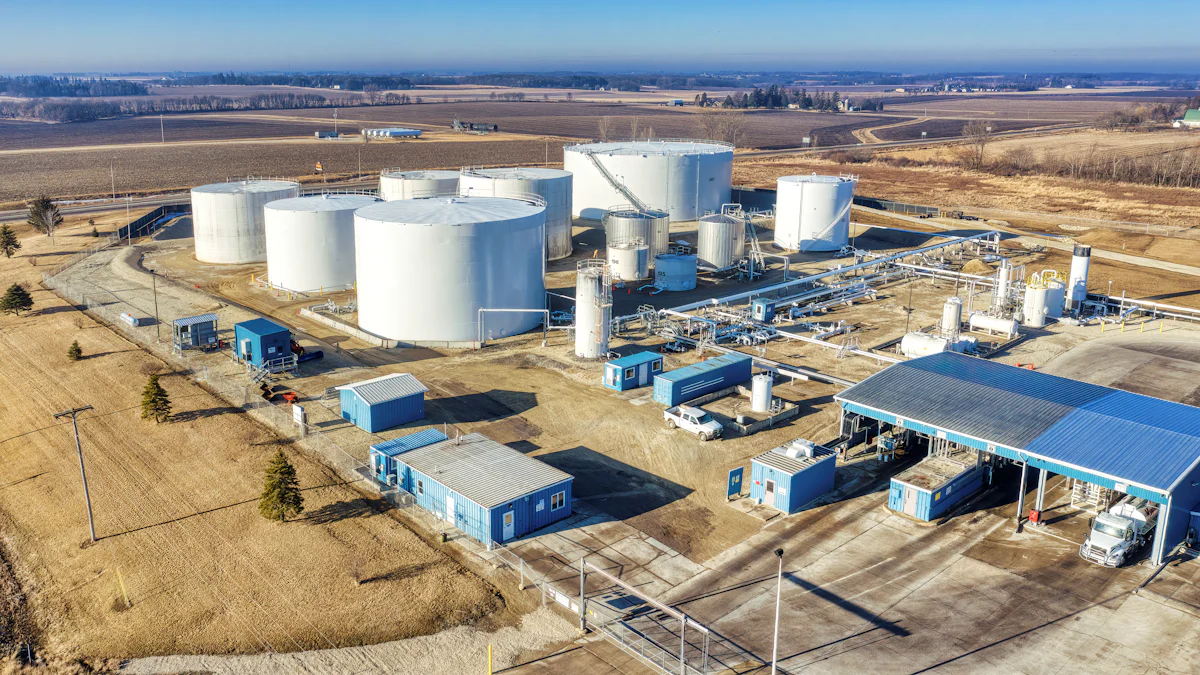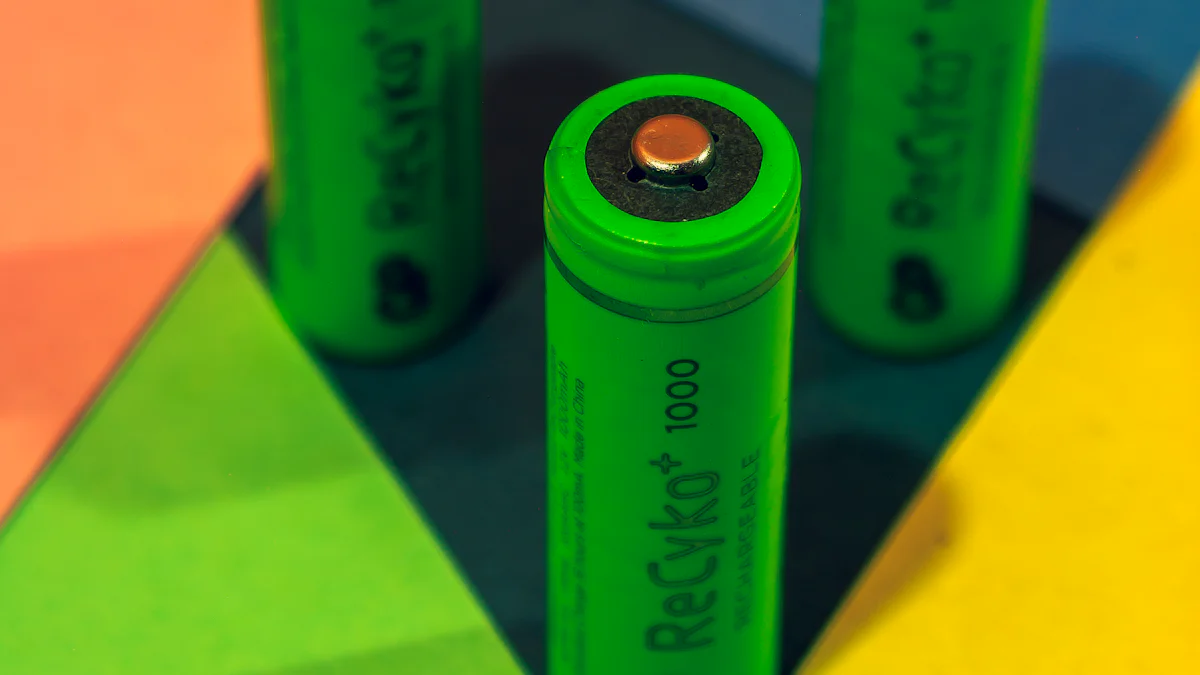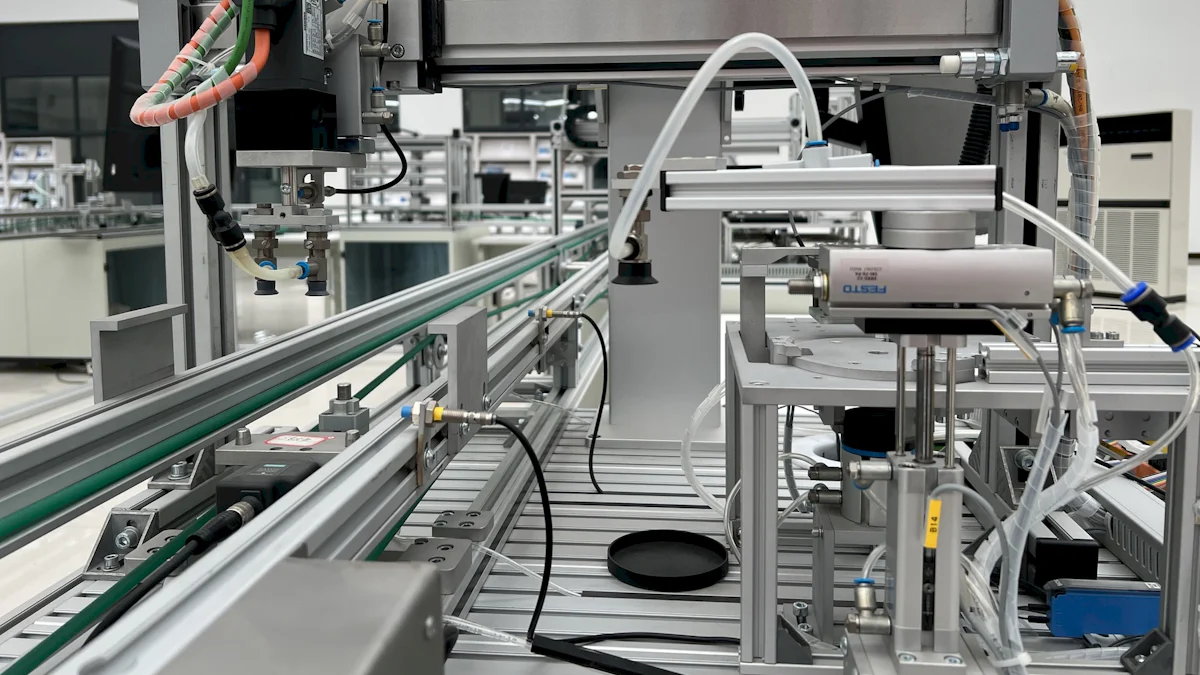
In 2025, the alkaline battery manufacturing process has reached new heights of efficiency and sustainability. I have seen remarkable advancements that enhance battery performance and meet the growing demands of modern devices. Manufacturers now focus on improving energy density and discharge rates, which significantly extend battery life. Eco-friendly designs and recyclable materials have become standard, reducing environmental impact. Closed-loop recycling systems and smart technology integration further demonstrate the industry’s commitment to sustainability. These innovations ensure that alkaline batteries remain reliable and environmentally responsible, meeting both consumer needs and global sustainability goals.
Key Takeaways
- Making alkaline batteries in 2025 focuses on being efficient and eco-friendly.
- Important materials like zinc and manganese dioxide help batteries work well.
- These materials are purified carefully to make them perform better.
- Machines and new technology make production faster and create less waste.
- Recycling and using recycled parts help protect the environment and stay sustainable.
- Strict testing ensures batteries are safe, reliable, and work as expected.
Overview of Alkaline Battery Manufacturing Components
Understanding the components of an alkaline battery is essential to grasp its manufacturing process. Each material and structural element plays a critical role in ensuring the battery’s performance and reliability.
Key MaterialsZinc and Manganese Dioxide
I have observed that zinc and manganese dioxide are the primary materials used in alkaline battery manufacturing. Zinc serves as the anode, while manganese dioxide acts as the cathode. Zinc, often in powdered form, increases the surface area for chemical reactions, enhancing efficiency. Manganese dioxide facilitates the electrochemical reaction that generates electricity. These materials are carefully purified and processed to ensure optimal performance.
Potassium Hydroxide Electrolyte
Potassium hydroxide functions as the electrolyte in alkaline batteries. It enables ion movement between the anode and cathode, which is vital for the battery’s operation. This substance is highly conductive and stable, making it ideal for maintaining consistent energy output.
Steel Casing and Separator
The steel casing provides structural integrity and houses all the internal components. It also acts as the cathode’s external contact. Inside, a paper separator ensures that the anode and cathode remain apart while allowing ionic flow. This design prevents short circuits and maintains the battery’s functionality.
Battery StructureAnode and Cathode Design
The anode and cathode are designed to maximize efficiency. Zinc powder forms the anode, while manganese dioxide creates the cathode mixture. This configuration ensures a steady flow of electrons during use. I have seen how precise engineering in this area directly impacts the battery’s energy density and lifespan.
Separator and Electrolyte Placement
The separator and electrolyte placement are crucial for the battery’s operation. The separator, typically made of paper, prevents direct contact between the anode and cathode. Potassium hydroxide is strategically placed to facilitate ion exchange. This meticulous arrangement ensures the battery operates safely and efficiently.
The combination of these materials and structural elements forms the backbone of alkaline battery manufacturing. Each component is optimized to deliver reliable performance and meet modern energy demands.
Step-by-Step Alkaline Battery Manufacturing Process

Preparation of Materials
Purification of Zinc and Manganese Dioxide
Purifying zinc and manganese dioxide is the first step in alkaline battery manufacturing. I rely on electrolytic methods to achieve high-purity materials. This process is essential because impurities can compromise battery performance. Electrolytic manganese dioxide (EMD) has become the standard due to the depletion of natural resources. Artificially produced MnO2 ensures consistent quality and reliability in modern batteries.
Mixing and Granulation
Once purified, I mix manganese dioxide with graphite and potassium hydroxide solution to create the cathode material. This mixture forms a black granulated substance, which I press into rings. These cathode rings are then inserted into steel cans, typically three per battery. This step ensures uniformity and prepares the components for assembly.
Component Assembly
Cathode and Anode Assembly
The cathode rings are carefully placed inside the steel casing. I apply a sealant to the inner wall of the can’s bottom to prepare for the sealing ring installation. For the anode, I inject a zinc gel mixture, which includes zinc powder, potassium hydroxide electrolyte, and zinc oxide. This gel is inserted into the separator, ensuring proper placement for optimal performance.
Insertion of Separator and Electrolyte
I roll separator paper into a small tube and seal it at the bottom of the steel can. This separator prevents direct contact between the anode and cathode, avoiding short circuits. I then add the potassium hydroxide electrolyte, which the separator and cathode rings absorb. This process takes about 40 minutes to ensure uniform absorption, a critical step for consistent energy output.
Sealing and Finalization
Sealing the Battery Casing
Sealing the battery is a meticulous process. I apply sealing glue to block capillary channels between the steel cylinder and the sealing ring. The sealing ring’s material and structure are enhanced to improve the overall sealing effect. Finally, I bend the upper edge of the steel can over the stopper unit, ensuring a secure closure.
Labeling and Safety Markings
After sealing, I label the batteries with essential information, including safety markings and specifications. This step ensures compliance with industry standards and provides users with clear guidance. Proper labeling also reflects the commitment to quality and safety in alkaline battery manufacturing.
Each step in this process is designed to maximize efficiency and ensure the production of high-quality batteries. By following these precise methods, I can meet the growing demands of modern devices while maintaining reliability and sustainability.
Quality Assurance
Ensuring the quality of every battery is a critical step in alkaline battery manufacturing. I follow rigorous testing protocols to guarantee that each product meets the highest standards of performance and safety.
Electrical Performance Testing
I begin by evaluating the electrical performance of the batteries. This process involves measuring voltage, capacity, and discharge rates under controlled conditions. I use advanced testing equipment to simulate real-world usage scenarios. These tests confirm that the batteries deliver consistent energy output and meet the required specifications. I also monitor the internal resistance to ensure efficient energy transfer. Any battery that fails to meet these benchmarks is immediately removed from the production line. This step ensures that only reliable products reach the market.
Safety and Durability Checks
Safety and durability are non-negotiable in battery production. I conduct a series of stress tests to evaluate the batteries’ resilience under extreme conditions. These tests include exposure to high temperatures, mechanical shocks, and prolonged usage. I also assess the sealing integrity to prevent leakage of the electrolyte. By simulating harsh environments, I ensure that the batteries can withstand real-life challenges without compromising safety. Additionally, I verify that the materials used are non-toxic and comply with environmental regulations. This comprehensive approach guarantees that the batteries are both safe for consumers and durable over time.
Quality assurance is not just a step in the process; it is a commitment to excellence. By adhering to these stringent testing methods, I ensure that every battery performs reliably and safely, meeting the demands of modern devices.
Innovations in Alkaline Battery Manufacturing in 2025

Technological Advancements
Automation in Production Lines
Automation has revolutionized alkaline battery manufacturing in 2025. I have seen how advanced technologies streamline production, ensuring precision and efficiency. Automated systems handle raw material feeding, electrode sheet production, battery assembly, and finished product testing.
| Process | Automation Technology Used |
|---|---|
| Raw Material Feeding | Automatic feeding systems |
| Electrode Sheet Production | Automated cutting, stacking, laminating, and winding |
| Battery Assembly | Robotic arms and automated assembly systems |
| Finished Product Testing | Automated testing and unloading systems |
AI-driven analytics optimize production lines by reducing waste and operational costs. Predictive maintenance powered by AI anticipates equipment failures, minimizing downtime. These advancements enhance precision in assembly, improving battery performance and reliability.
Enhanced Material Efficiency
Material efficiency has become a cornerstone of modern manufacturing. I have observed how manufacturers now use advanced techniques to maximize the utility of raw materials. For instance, zinc and manganese dioxide are processed with minimal waste, ensuring consistent quality. Enhanced material efficiency not only reduces costs but also supports sustainability by conserving resources.
Sustainability Improvements
Use of Recycled Materials
In 2025, alkaline battery manufacturing increasingly incorporates recycled materials. This approach minimizes environmental impact while promoting sustainability. Recycling processes recover valuable materials like manganese, zinc, and steel. These materials offset the need for raw material extraction, creating a more sustainable production cycle. Zinc, in particular, can be recycled indefinitely and finds applications in other industries. Steel recycling eliminates energy-intensive steps in raw steel production, saving significant resources.
Energy-Efficient Manufacturing Processes
Energy-efficient processes have become a priority in the industry. I have seen manufacturers adopt technologies that reduce energy consumption during production. For example, optimized heating systems and renewable energy sources power many facilities. These measures lower carbon emissions and align with global sustainability goals. By integrating energy-efficient practices, manufacturers ensure that alkaline battery production remains environmentally responsible.
The combination of technological advancements and sustainability improvements has transformed alkaline battery manufacturing. These innovations not only enhance efficiency but also reflect a commitment to environmental stewardship.
Environmental Impact and Mitigation in Alkaline Battery Manufacturing
Environmental Challenges
Resource Extraction and Energy Use
The extraction and processing of raw materials like manganese dioxide, zinc, and steel create significant environmental challenges. Mining these materials generates waste and emissions, which harm ecosystems and contribute to climate change. These materials make up about seventy-five percent of an alkaline battery’s composition, highlighting their critical role in the environmental footprint of alkaline battery manufacturing. Additionally, the energy required to process these raw materials adds to the industry’s carbon emissions, further exacerbating its environmental impact.
Waste and Emissions
Waste and emissions remain persistent issues in the production and disposal of alkaline batteries. Recycling processes, while beneficial, are energy-intensive and often inefficient. Improper disposal of batteries can lead to toxic substances, such as heavy metals, leaching into soil and water. Many batteries still end up in landfills or are incinerated, wasting the resources and energy used in their production. These challenges underscore the need for more effective waste management and recycling solutions.
Mitigation Strategies
Recycling Programs
Recycling programs play a vital role in reducing the environmental impact of alkaline battery manufacturing. These programs recover valuable materials like zinc, manganese, and steel, reducing the need for raw material extraction. However, I have observed that the recycling process itself can be energy-intensive, limiting its overall efficiency. To address this, manufacturers are investing in advanced recycling technologies that minimize energy consumption and improve material recovery rates. By enhancing these programs, we can reduce waste and promote a more sustainable production cycle.
Adoption of Green Manufacturing Practices
Green manufacturing practices have become essential in mitigating environmental challenges. I have seen manufacturers adopt renewable energy sources to power production facilities, significantly lowering carbon emissions. Energy-efficient technologies, such as optimized heating systems, further reduce energy consumption during production. Additionally, the use of recycled materials in manufacturing helps conserve natural resources and minimizes waste. These practices reflect a commitment to sustainability and ensure that alkaline battery production aligns with global environmental goals.
Addressing environmental challenges requires a multifaceted approach. By combining effective recycling programs with green manufacturing practices, we can mitigate the impact of alkaline battery manufacturing and contribute to a more sustainable future.
The alkaline battery manufacturing process in 2025 showcases remarkable advancements in efficiency, sustainability, and innovation. I have seen how automation, material optimization, and energy-efficient practices have transformed production. These improvements ensure that batteries meet modern energy demands while minimizing environmental impact.
Sustainability remains critical for the future of alkaline battery production:
- Inefficient raw material use and improper disposal pose environmental risks.
- Recycling programs and biodegradable components offer promising solutions.
- Educating consumers about responsible recycling reduces waste.
The alkaline battery market is projected to grow significantly, reaching $13.57 billion by 2032. This growth highlights the industry’s potential for continued innovation and environmental stewardship. By embracing sustainable practices and cutting-edge technology, I believe alkaline battery manufacturing will lead the way in meeting global energy needs responsibly.
FAQ
What makes alkaline batteries different from other types of batteries?
Alkaline batteries use potassium hydroxide as an electrolyte, which provides higher energy density and longer shelf life compared to zinc-carbon batteries. They are non-rechargeable and ideal for devices requiring consistent power, such as remote controls and flashlights.
How are recycled materials used in alkaline battery manufacturing?
Recycled materials like zinc, manganese, and steel are processed and reintegrated into production. This reduces the need for raw material extraction, conserves resources, and supports sustainability. Recycling also minimizes waste and aligns with global environmental goals.
Why is quality assurance critical in alkaline battery production?
Quality assurance ensures batteries meet performance and safety standards. Rigorous testing evaluates electrical output, durability, and sealing integrity. This guarantees reliable products, prevents defects, and maintains consumer trust in the brand.
How has automation improved alkaline battery manufacturing?
Automation streamlines production by handling tasks like material feeding, assembly, and testing. It enhances precision, reduces waste, and lowers operational costs. AI-driven analytics optimize processes, ensuring consistent quality and efficiency.
What are the environmental benefits of green manufacturing practices?
Green manufacturing reduces carbon emissions and energy consumption. Using renewable energy sources and recycled materials minimizes environmental impact. These practices promote sustainability and ensure responsible production methods.
Media Contact
Company Name: Yuyao Johnson Eletek Co., Ltd
Contact Person: Johnson
Email: Send Email
Country: China
Website: https://www.zscells.com/

